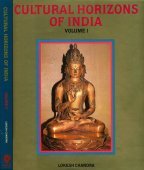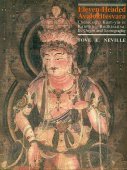Flesh: 1 definition
Introduction:
Flesh means something in Hinduism, Sanskrit. If you want to know the exact meaning, history, etymology or English translation of this term then check out the descriptions on this page. Add your comment or reference to a book if you want to contribute to this summary article.
In Hinduism
Shaktism (Shakta philosophy)
Source: ORA: Amanaska (king of all yogas): (shaktism)Flesh is denoted by the Sanskrit term Māṃsa, according to the 17th century Kaulagajamardana (“crushing the Kaula elephant”) authored by Kāśīnātha or Kṛṣṇānandācala.—Accordingly, [as Īśvara said to Pārvatī]: “Listen, O Pārvatī, I shall give a critique of the Pāṣaṇḍas. Knowing this, a wise man is not defeated by them. [...] He who wears ash from the cremation ground and delights in wine and flesh (māṃsa); he who performs such [rites] as bathing and the junctures for [mere] worldly rewards; and he who is the vilest [of them all,] having become a hater of Viṣṇu, destroys everything; [all of them] are called Pāṣaṇḍas. [Now,] my dear, hear about the Kāpālika. [...]”

Shakta (शाक्त, śākta) or Shaktism (śāktism) represents a tradition of Hinduism where the Goddess (Devi) is revered and worshipped. Shakta literature includes a range of scriptures, including various Agamas and Tantras, although its roots may be traced back to the Vedas.
See also (Relevant definitions)
Starts with: Boar flesh, Flesh and blood, Flesh water, Fleshy spurge, Horse flesh, Human flesh, Pigeon meat.
Query error!
Full-text (+1980): Mamsa, Amisa, Pisita, Kravya, Vallura, Mahamamsa, Shaushkala, Shushkala, Kravyada, Tarasa, Lohamisha, Putimamsa, Samisa, Saptadhatu, Jarutha, Amamsha, Shashkula, Amamamsa, Asraja, Kardama.
Relevant text
Search found 414 books and stories containing Flesh; (plurals include: Fleshes). You can also click to the full overview containing English textual excerpts. Below are direct links for the most relevant articles:
Charaka Samhita (English translation) (by Shree Gulabkunverba Ayurvedic Society)
Chapter 27c - The group of meats (Mamsa) < [Sutrasthana (Sutra Sthana) — General Principles]
Chapter 8 - The therapeutics of Consumption (raja-yakshma-cikitsa) < [Cikitsasthana (Cikitsa Sthana) — Section on Therapeutics]
Chapter 27 - Diet and Dietetics (Annapana-vidhi) < [Sutrasthana (Sutra Sthana) — General Principles]
Markandeya Purana (Study) (by Chandamita Bhattacharya)
Rules and restrictions of Śrāddha < [Chapter 3]
Duties (Āhnika) or Moral obligation < [Chapter 2]
Non-vegetarian food < [Chapter 2]
Devi Bhagavata Purana (by Swami Vijñanananda)
Chapter 9 - On the rules of Śirovrata < [Book 11]
Chapter 22 - On the narrative of the sins leading to hells < [Book 8]
Chapter 23 - On the description of the remaining hells < [Book 8]
Expiatory Rites in Keralite Tantra (by T. S. Syamkumar)
1.2. Expiatory Rites in Śaivāgamanibandhana < [Chapter 3 - Expiatory Rites in Kerala Tantric Ritual Manuals]
1.5. Expiatory Rites In Rauravāgama < [Chapter 2 - Expiatory Rites in Āgamic Literature]
3. Expiatory Rites in Śākta-Tantras < [Chapter 2 - Expiatory Rites in Āgamic Literature]
International Ayurvedic Medical Journal
Paradigm shift in diet and lifestyle for ocular health < [2023, Issue 07, July]
Diet and prediabetes – a survey based study < [2018, Issue I, january,]
Importance of aahar and aahar varga w.s.r. shook dhanya varga as per charak samhita and its significance in the present era < [2024, Issue 07. July]
World Journal of Pharmaceutical Research
Pharmacognostic and pharmacological review on choerospondias axillaris < [2022: Volume 11, May issue 5]
Ft-ir and uv-vis spectroscopy photochemical analysis of dragon fruit < [2017: Volume 6, December special issue 17]
Seasonal nutritional variation in key Bangladeshi fish species < [2020: Volume 9, May issue 5]
Related products


